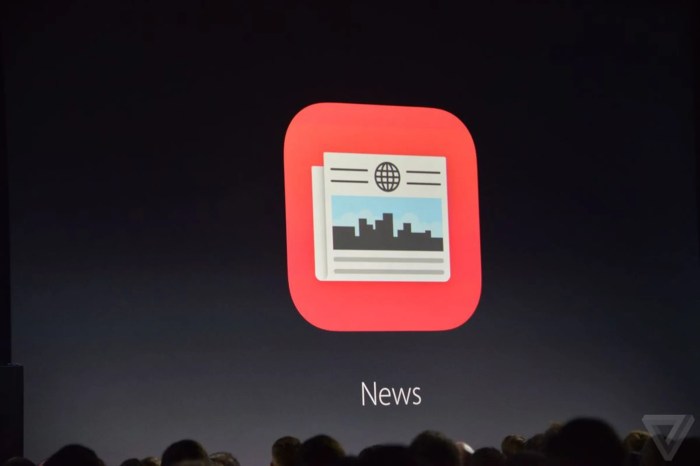Publishers not happy apple news – Publishers Not Happy: Apple News Fallout – The tech giant’s news aggregator is causing a stir, leaving many publishers feeling squeezed and frustrated. This isn’t just about a few disgruntled voices; it’s a deeper dive into the complex relationship between tech giants and the media landscape. We’re unpacking the financial implications, the control battles, and the future of news in the age of Apple.
From revenue-sharing models that leave publishers with crumbs to content control issues that stifle editorial freedom, the Apple News platform presents a mixed bag. This article explores the experiences of various publishers, both big and small, highlighting the challenges they face and the strategies they employ to navigate this increasingly complicated ecosystem. We’ll examine the impact on audience reach, the competitive landscape, and the ever-present risk of platform dependence.
Financial Impact on Publishers: Publishers Not Happy Apple News

Apple News, while boasting a massive reach, has left many publishers questioning the true value of its platform. The initial allure of tapping into Apple’s vast user base often clashes with the harsh realities of its revenue-sharing model, leaving some feeling financially shortchanged. Let’s delve into the complexities of this relationship and its impact on publishers’ bottom lines.
Apple News’s revenue-sharing model, while not publicly disclosed in precise detail, is generally understood to offer publishers a fraction of the advertising revenue generated from articles displayed within the app. This percentage is often considered significantly lower than what publishers could earn through their own websites or apps, where they retain a larger share of the advertising revenue. This disparity creates a considerable financial disadvantage for many.
Revenue Loss Due to Apple News’s Revenue-Sharing Model
The exact revenue loss varies greatly depending on factors like the publisher’s size, audience engagement within Apple News, and the overall advertising market. However, numerous anecdotal reports suggest that the revenue generated through Apple News often fails to compensate for the time, resources, and effort invested in creating and optimizing content for the platform. Many publishers report earning significantly less per article view on Apple News compared to their own platforms. The opaque nature of Apple’s revenue-sharing calculations further exacerbates this issue, making it difficult for publishers to accurately assess their return on investment.
Comparison of Financial Performance Before and After Joining Apple News
Several case studies, though not always publicly available, indicate a decline in overall revenue for some publishers following their integration with Apple News. While some smaller publishers might see a slight increase in traffic, the meager revenue share often fails to offset the potential losses from diverting resources away from more profitable ventures. Larger publishers, with more diversified revenue streams, may experience less dramatic shifts, but the overall impact on their financial performance remains a point of contention. A thorough analysis comparing pre- and post-Apple News financial data for a representative sample of publishers is necessary for a comprehensive understanding.
Examples of Publishers Experiencing Significant Financial Setbacks
While specific financial figures are rarely made public due to confidentiality agreements, numerous reports suggest that many smaller, independent publishers have experienced financial difficulties after joining Apple News. The lack of transparency regarding Apple’s revenue-sharing formula, coupled with the low payouts, has made it challenging for these publishers to justify their participation in the long term. The situation is further complicated by the high operational costs associated with content creation and distribution, making it difficult for them to break even, let alone turn a profit. The struggle is particularly acute for publishers who heavily rely on advertising revenue.
Hypothetical Scenario: A Small, Independent Publisher
Consider a small, independent publisher specializing in niche topics, such as artisanal cheesemaking. They dedicate significant time and resources to crafting high-quality articles, hoping to attract a loyal audience. Joining Apple News initially seems promising, offering access to a large potential readership. However, after several months, they discover that the revenue generated through Apple News barely covers the costs of creating and optimizing the content for the platform. Their overall revenue might even decline, as they divert resources from their own website, which previously generated a higher return on investment. This illustrates the potential for financial setbacks even for publishers who are passionate and dedicated to their work. The situation highlights the need for a more transparent and equitable revenue-sharing model.
Competition and Market Dynamics
Apple News’s entry into the news aggregation game significantly reshaped the competitive landscape for publishers. It introduced a powerful new player with a massive, built-in audience, forcing publishers to reconsider their distribution strategies and revenue models. The impact, however, isn’t uniformly positive, creating both opportunities and challenges.
Apple News affects the competitive landscape by offering a direct distribution channel to millions of Apple device users. This bypasses traditional news websites and apps, potentially reducing traffic and advertising revenue for publishers who rely heavily on these channels. Simultaneously, it presents a new avenue for reaching a large audience, potentially expanding readership and brand awareness. The dynamic is complex, and the overall effect depends on a publisher’s strategy and ability to adapt.
Apple News Versus Other Aggregators
Apple News boasts a considerable advantage in its massive user base, integrated seamlessly into the Apple ecosystem. This provides a level of reach that few other aggregators can match. However, this comes with limitations. Unlike some competitors, Apple News offers less control over presentation and monetization strategies for publishers. Other aggregators, such as Google News, may offer more flexibility in customization and advertising integration, albeit often with a less captive audience. The choice between platforms hinges on a publisher’s priorities: prioritizing reach versus control.
Successful and Unsuccessful Apple News Strategies
Some publishers have thrived within the Apple News ecosystem by focusing on high-quality content optimized for the platform’s format. For instance, publications specializing in visually rich storytelling, like National Geographic, have seen success. Their visually stunning articles translate well to the Apple News format, attracting a significant readership. Conversely, publishers who have failed to adapt their content to the platform’s limitations, or who have not actively engaged with Apple News’s audience, have seen less success. A lack of consistent updates and engagement with the platform’s features can lead to decreased visibility and reader interaction.
A Multi-Platform Strategy for News Publishers
A successful strategy for news publishers involves diversification. Relying solely on Apple News, or any single platform, is risky. A balanced approach requires a strong presence across multiple channels. This includes maintaining a robust website and app, actively engaging on social media, and exploring other news aggregators and distribution partnerships. Simultaneously, publishers should strategically optimize content for Apple News, ensuring visually appealing and concise articles that cater to the platform’s user experience. This diversified approach mitigates the risks associated with relying on any single platform and maximizes reach while maintaining control over brand messaging and monetization.
User Experience and Content Presentation

Apple News, while boasting a massive user base, presents a complex picture for publishers regarding user experience and content presentation. The platform’s design choices, while aiming for a streamlined reading experience, often clash with publishers’ desires for brand consistency and optimal content delivery. This leads to a tension between platform standardization and individual publisher identity.
The user experience on Apple News is a double-edged sword. For readers, the clean interface and curated content feeds can be appealing, offering a convenient way to discover new sources and topics. The ease of navigation and consistent format across publications might attract readers who prefer a uniform reading experience. However, this uniformity can also lead to a lack of visual distinction between publications, potentially hindering brand recognition and loyalty. For publishers, the experience is more nuanced. While reaching a potentially vast audience is attractive, the limitations imposed by Apple’s design and formatting requirements can restrict creative control and potentially impact engagement metrics. The lack of granular analytics can also make it difficult to understand precisely how content performs within the Apple News ecosystem.
Reader Experience on Apple News
Readers encounter a largely standardized presentation across different publishers. Articles generally follow a similar layout, with headlines, images, and text blocks presented in a consistent format. This consistency can lead to a feeling of homogeneity, where individual publication branding is less prominent. While this might improve discoverability for smaller publishers, it could potentially diminish the impact of established brands with unique design aesthetics. For instance, a publication known for its bold visuals might find its unique style diluted within the Apple News framework. The emphasis on a streamlined reading experience often means that publishers’ carefully curated design elements might be overridden by Apple News’s default settings.
Publisher Experience and Content Control
Publishers often face challenges in maintaining their brand identity within the confines of Apple News’s design parameters. Custom fonts, specific layouts, and interactive elements are often limited or disallowed, resulting in a less personalized reading experience for the audience compared to the publisher’s own website or app. The inability to embed videos or other rich media formats in the way publishers would like can restrict the delivery of multimedia content, impacting the overall user engagement. For example, a publication relying heavily on video content for breaking news coverage might find its reach limited by Apple News’s restrictions. This lack of flexibility in content presentation can frustrate publishers who aim to create a unique and engaging reading experience for their audience.
Comparison with Other News Platforms
Compared to other platforms like Google News or dedicated news apps, Apple News often presents a more curated and visually uniform experience. Platforms like Google News prioritize algorithm-driven recommendations and allow for more variability in content presentation. Dedicated news apps, on the other hand, offer publishers maximum control over the layout, design, and functionality of their content. Apple News sits somewhere in between, offering broad reach but at the cost of creative control. The curated nature of Apple News, while beneficial for discovery, might not suit publishers who prioritize individual brand identity and sophisticated content delivery.
Content Presentation Issues Encountered by Publishers
Publishers have reported difficulties maintaining brand consistency due to the restrictive formatting options within Apple News. The inability to implement custom fonts, color palettes, and interactive elements significantly impacts brand recognition and user experience. Another recurring issue is the limitations on multimedia content integration. Publishers accustomed to incorporating videos, audio clips, and interactive infographics into their articles might find their content downgraded or simplified within the Apple News environment. This can lead to a less engaging experience for readers and reduced effectiveness of the content itself. Finally, the lack of granular analytics can make it difficult to measure the effectiveness of content strategies within the Apple News ecosystem, hindering optimization efforts.
Alternative Content Formats for Improved User Experience, Publishers not happy apple news
To enhance the user experience on Apple News, publishers could explore alternative content formats that better leverage the platform’s strengths while mitigating its limitations. More flexible templates allowing for greater customization within Apple’s guidelines could be developed. For example, allowing publishers to define custom sections or use specific color schemes while remaining within the platform’s overall design could enhance brand recognition. Additionally, improving the integration of multimedia elements, perhaps through better support for interactive graphics or short video clips, could significantly boost engagement. A more robust analytics system offering detailed insights into reader behavior within the Apple News environment would also be highly beneficial, empowering publishers to optimize their content strategies more effectively.
The Apple News saga underscores a larger conversation about the power dynamics between tech platforms and content creators. While Apple News offers potential reach, its limitations regarding financial compensation, editorial control, and platform dependence raise serious concerns for publishers. The future likely involves a more nuanced approach, with publishers diversifying their strategies and demanding fairer terms from tech giants. The fight for fair compensation and editorial integrity is far from over.



